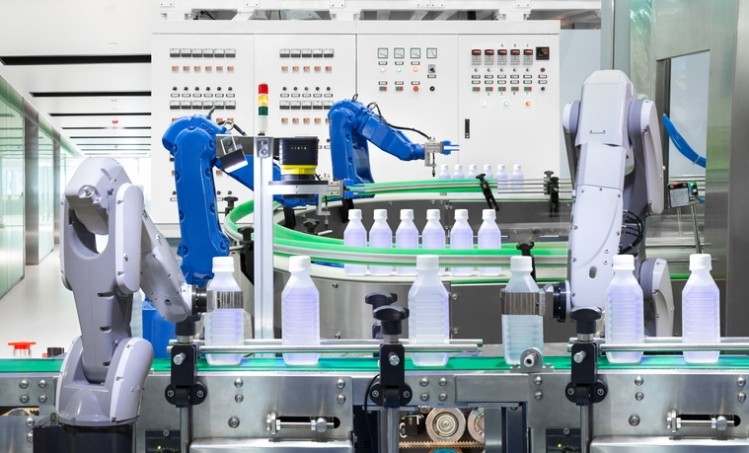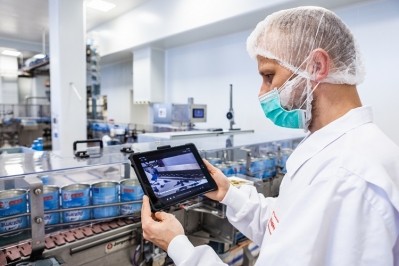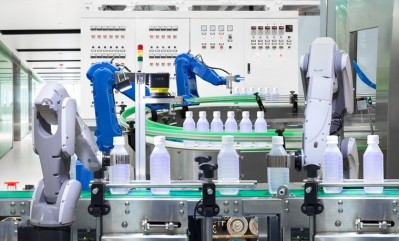‘Smart manufacturing can make all the difference’: How tech is transforming food production

The food and beverage industry is ‘more complex and fast-changing’ than ever before, according to the assessment of Andrew Smith, Regional Segment Leader – Process & Packaging OEMs at Rockwell Automation.
Food makers are having to rapidly adapt their processes and products to keep up with changing markets and consumer demands. Smith believes that the pressure is rising – and much of it stems from elevated consumer expectations.
“Today’s consumers are more outspoken and connected. For example, they can shop for food and other essential items from the comfort of their own homes with the ability to easily view all their options and compare prices from other supermarkets with just a few clicks,” he observed.
E-commerce is a trend that has accelerated under COVID-19 – and it is one that does not look set to abate. Data from shopper insight specialist IRI predicts European FMCG e-commerce sales will rise by 54% to reach €56bn by 2022.
Digitalisation also means that competition from new sources is rising, with direct-to-consumer sales boosting speciality and local producers.
“With consumer trends and tastes rapidly changing, food and beverage manufacturers need to be able to quickly respond to the speed of these market dynamics. So, how can companies keep up? To remain competitive, food and beverage manufacturing systems must optimise productivity and perform at the highest standard. This requires comprehensive and continuous operations improvement,” Smith suggested.
‘Smart manufacturing’ could offer a solution.
The Rockwell Automation executive elaborated: “Connected, information-enabled manufacturing – or smart manufacturing – can make all the difference. New technologies are helping food and beverage manufacturers better understand and use their food processing operations. Smart manufacturing can help improve asset utilization, increase yield, drive workforce productivity, optimize resource management and mitigate security risks.”
Data driven productivity gains
Smith explained that smart manufacturing uses data to create a ‘single view’ of operations, facilitating communication between people, data and assets.
This means that when new challenges present themselves, food makers are able to ‘avoid downtime’ and optimise processes in a way that was ‘previously unimaginable’, he told us.
“New developments in technology are redefining food and beverage manufacturing. By combining the Internet of Things, wireless and mobile technologies, data analytics and network infrastructure, companies can access and act on the data from their operations before a potential problem arises.”
Smith pointed to the example of Tyson Foods-owned Hillshire Brands. “When Hillshire Brands implemented a manufacturing intelligence system at their plant in Haltom City, Texas, the food manufacturer reduced inedible product and waste goals to 0.8% – saving about 5.5 million corn dogs per year.”
Through smart manufacturing, data can be leveraged to improve competitiveness and unlock significant productivity gains, effectively shining a light on areas of waste that manufacturers would have struggled to identify.
“We know we must improve productivity in manufacturing, but what opportunities exist? Without more detailed insight and understanding, it’s challenging to drive continuous productivity. There are losses and issues slipping under the radar that can result in costly and time-consuming consequences,” Smith said.
“Smart, flexible manufacturing brings new challenges to the workforce in achieving productivity goals while minimising change overs and machine downtime. Advanced technologies like analytics have the power to detect issues and challenges that live in your production plant consistently. You can bring these issues to the surface and increase capacity, productivity and yield. Augmented Reality coupled with advanced analytics deliver predictive maintenance functionality while overcoming the workforce skills gaps that many producers are facing today.”
Smart manufacturing and smart machines: ‘A new era of flexible production’
Smart manufacturing and smart machines allow food makers to increase agility and flexibility in their production processes while also driving resource efficiency, according to Smith.
He believes this is especially important in the context of evolving consumption patterns. “Today’s customers want choices,” he noted.
“This modern appetite for variety among consumers means food and beverage companies need machines that do more, faster – without adding production lines for each new product. That means more frequent changeovers, effective batch and recipe management tools, using the same machine for multiple jobs and being flexible enough to meet future consumer demands.
“Technology solutions like independent cart technology (ICT) and robotics can deliver much-needed flexibility on a production line. ICT provides the foundation for intelligent conveyance systems – advanced and efficient alternatives to conventional systems. These unique systems can safely and efficiently manage many carts across a network of linear motors. Using ICT, some OEMs have reduced changeovers from 45 minutes to just one. Overall, ICT minimizes complications and reduces time to market for food and beverage producers.
“Robotics can also offer more flexibility to end-of-the-line operations, like packaging. Smart machines based around a single control system with robotic controls can enable faster communication of control, safety and process information and more accurate control of machine movements.
“In addition, advances in scalable batch and recipe management tools allow food companies to build more flexible production lines. In the past, a line may have been dedicated to a single product, but companies can now easily and efficiently change recipes on the same line.”
Emerging tech shaping the future of production
If all this is possible through smart machines today, what tech does Smith believe will shape the future of food production?
“The COVID-19 pandemic ushered in a period of rapid acceleration of digital transformation initiatives in the industrial sector. What normally takes years to innovate and implement happened in a matter of months. This transformation has been supported by technologies that were already on the market, but which have seen their implementation accelerate. Thus, 2021 will be marked by an increasingly widespread adoption of flexible manufacturing, augmented reality, predictive maintenance, Edge Computing and Digital Thread,” he predicted.
Smith’s top tech picks:
- Flexible Manufacturing
Flexible manufacturing is the speed manufacturers adapt to changes in the market. It's about creating a smooth flow from need to delivery. Flexibility allows manufacturers to stay in line with their market by replacing rigid operating models with levels of control and responsiveness that they never thought were feasible before.
- Augmented Reality
Augmented reality (AR) is a technology that allows users to view and interact with real-world environments through computer generated superimposed images. It enables workers to perform better and avoid safety and compliance risks by providing easy access to the information they need online. AR technologies also form part of the Industry 4.0 digital transformation, and 2021 will see increasing levels of adoption.
Augmented reality also offers an infinite number of development perspectives and opportunities as it can be integrated into various processes and industries. Manufacturers are applying AR to the plant to help solve problems in real time. By using an augmented reality application a technician can view their equipment in real time to indicate the specific instructions needed to repair it. Even three-dimensional spatial indications can be made on the screen, so you know exactly which component of the machine to pay attention to.
- Predictive maintenance
We will see the development of powerful machine learning algorithms and predictive analytics software to offer predictive and prescriptive maintenance. With these new tools, industrial operators will be able to forecast maintenance needs and perform necessary repairs before outages occur. They will be able to know in advance how and why a machine is degrading and what corrective actions to take. This enables manufacturers to avoid costly downtime and improve productivity.
- Edge Computing
In the smart factory, real-time availability of mission-critical workloads will be required to ensure business results. Edge computing will complement existing cloud infrastructure by enabling real-time data processing where work is done (for example, motors, pumps, generators, or other sensors). Implementing integrated analytics from the edge to the cloud will help these companies maximize the value of investments in digital systems.
- Digital Twin / Digital Thread
Manufacturers are exploring new ways to diagnose and solve problems, and much more, using advanced digital tools. One of these tools are digital twins which is the collection of data created in software representing a real-life system. Machines, controllers, processes, workflow, and any other aspect of a system can be represented digitally, without any interruption to ongoing activities.
Once "up and running," digital twins allow companies to explore methods that diagnose and solve machine and process problems, and experiment with systems to determine the most profitable start-up line. What-if modelling and risk assessments, testing for security features, and automatic governance compliance are just a few of the areas where using digital twins can also help.
Similar to a digital twin, the Digital Thread creates a virtual representation of how data travels within a company. The Digital Thread enables supervisory enhancements throughout the supply chain, including delivery of work instructions to operators, quality control sampling, and automated activation of components and materials from vendors, suppliers, and partners. The combination of Digital Twin and Digital Thread creates what Rockwell Automation (and the industry in general) refers to as "The Connected Enterprise."
In the near future, we will see that by interconnecting business systems through the Digital Thread, companies will practically start up new production lines. Using the digital twins, manufacturers will run machines virtually before parts are ordered, discover control issues before support personnel review them, predict future performance challenges and opportunities, simulate line changes to stay keep up with changing customer demands and will train new staff in non-stop systems of activity.
















